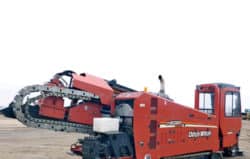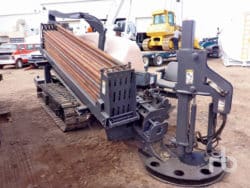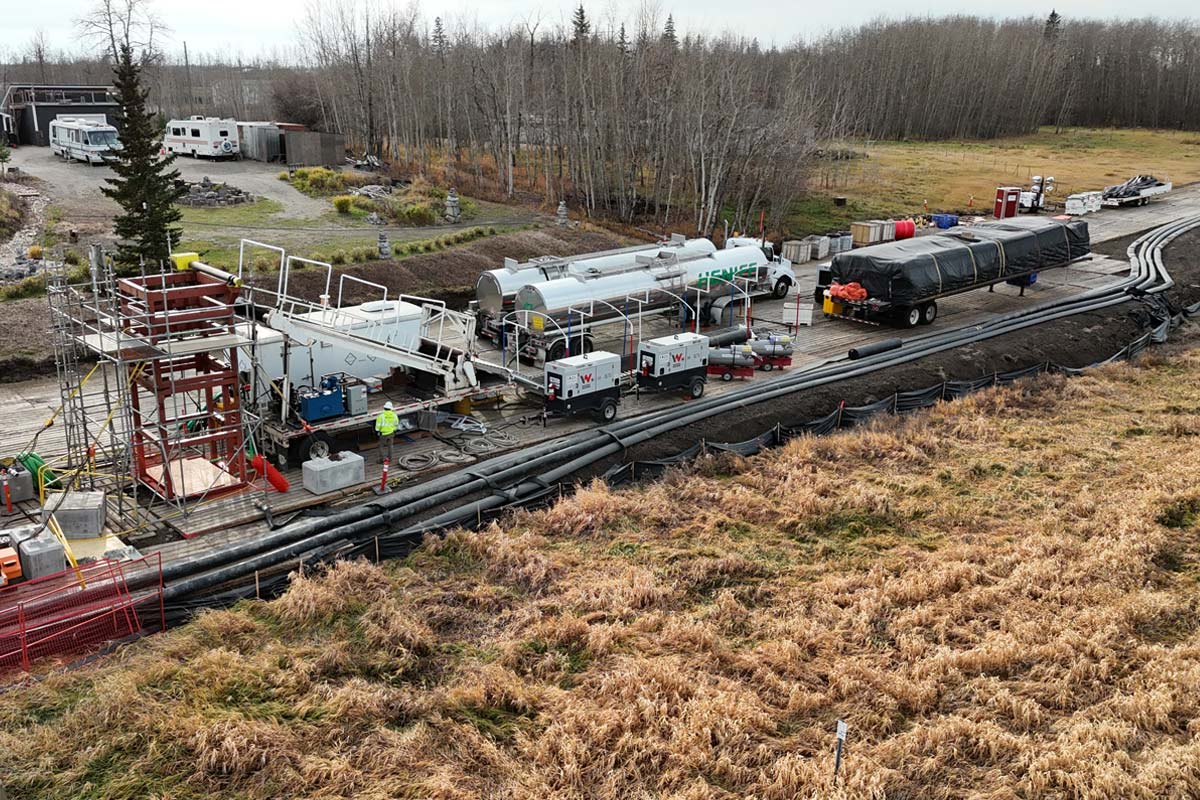
The Art of Sale: Ritchie Bros. Leads the Way in Industrial Equipment Auctions
July 21, 2016
One of the leaders in the global used equipment sales world calls British Columbia home and the company can trace its roots to — of all things — furniture.
It was 1958 and the Ritchie brothers – Ken, Dave and John – were in need of paying back a bank note for their furniture store in Kelowna, British Columbia. At the suggestion of a friend, the brothers decided to conduct an auction to decrease their surplus furniture and repay the note.
RELATED: Ritchie Bros. Introduces New Senior Leader to its U.S. Team
That grand plan worked out so well that the brothers formed Ritchie Bros. Auction Galleries Ltd. By 1963, they realized there was more money to be had in industrial sales, selling used equipment, as opposed to chrome-legged tables and vinyl chairs.
That inclination — that equipment sales were the way of the future and increased profitability — grew to become Ritchie Bros. Auctioneers, one of the largest and most recognized players on the global used equipment scene.
“We’re selling more than four billion dollars’ worth of generally used construction and transportation assets annually now,” says Randy Wall, Ritchie Bros. president, Canada. “We have 44 permanent auction sites and more than 100 sales offices worldwide in more than 20 countries.”
Going Unreserved
Auctions have become an accepted manner to trade, buy or sell used assets and in North America, it is almost the first option to move used assets.
In 2015, Ritchie Bros. sold $4.25 billion (USD) in equipment at its 345 unreserved auctions and the EquipmentOne online marketplace. Nearly 60 years after the first furniture auction, one of the cornerstones of the auction company’s first sales still holds true — it is the magic of the unreserved auction.
“The market has evolved very significantly. In the early days when we began, there were no national or international auction companies, just small regional players,” Wall says. “There wasn’t anyone selling on an unreserved basis; owners established minimum prices.”
While some consignors might be leery of the fact that their equipment may sell for a pittance of what it is worth, that is not the case.
“The answer is yes, in theory, equipment could sell for a dollar, but understand the psychology of the auction,” says Wall. “It’s survival of the fittest as he who has the most money in their hand for a particular item and is willing to bid, wins. There is a vast amount of competition from different industries as well, because a lot of different people can use the same type of truck in different industries.”
This variety of equipment coupled with knowing the purchaser can stay within a preset budget helps the auctions thrive. In 2015, the company sold more than 350,000 items for 47,600 consignors, and registered more than 500,000 bidders. In the first four months of 2016, Ritchie Bros. auctions attracted 14,450 consignors, 119,000 lots, 166,000 registered bidders and 41,350 buyers.
“That is the secret that lures in 2,200 people on average — or 10,000 to 15,000 at our large events,” Wall says.
“Those people are coming from very broad distribution of geographies. At these large auctions you’ll typically find people from more than 50 different countries are participating and virtually every state and every province.”
- This 2011 Ditch Witch JT4020 Mach 1 sold for $122,500 (CAD) at the April 2016 Edmonton auction.
- This 2000 CASE 6030 Turbo Crawler sold for $7,500 (CAD) at the April 2016 Edmonton auction.
Setting Records
One of the reasons for the increased bidder numbers is the pervasive reach of the Internet and Ritchie Bros. online bidding portal. Buyers have the ability to make purchases in real-time no matter where they live and the popularity of online bidding is growing. In 2015, online buyers accounted for $1.9 billion (USD) or 45 per cent of the company’s total sales. Wall notes that if a buyer finds the right asset at the right price, they will buy it from anywhere.
While a person in Dubai appreciates the ability to purchase a horizontal directional drill from Toronto, many bidders attend the live auction and, in many cases, an online bidder will have an associate on the ground at the auction for inspection purposes.
Benefits of Buying at the Auction
Whether bidding in person or online, there are a few things a buyer should keep in mind. Randy Wall, Ritchie. Bros. president, Canada, offers these helpful tips to make the auction experience a worthwhile one.
From a buyer’s perspective, Wall says there are three main benefits to buying from an auction vs. a dealer.
Choice: There is enormous choice. For example, the May 25 auction in Montreal, Quebec, had 1,306 industrial support items up for bid. This includes signs and arrow boards (9), welders (44), air compressors (34) and generator sets (29). A buyer can satisfy many project needs in one trip to an auction.
Delivery: In some cases, when buying new from a dealer, the equipment is not readily available or must be shipped from another location. At an auction, delivery is immediate.
Price: The buyer controls the price. They can set the limit they want to spend without any friction from the seller. Buying at the auction eliminates the haggling that occurs in a dealer situation. The buyer can also bid with confidence knowing they are going head-to-head with another potential buyer.
RELATED: Tips for Buying a Used or Previously Owned Skid Steer
Going into the auction it is best to plan ahead and arrive early. At the Ritchie Bros. website, a potential bidder can sign up for an account and receive prompts when certain equipment – down to the year and location – is coming up for auction. The potential bidder can also monitor prices from the auctions to establish their own market value for a particular item.
“Arrive early, either the day or weekend before to allow yourself enough time to have a good look at what is on offer and those items you are interested in. Start them up, have a look, make sure that you are satisfied with the condition and we’ll often have additional information in the office that was provided by the seller – maybe work orders or service history,” Wall says. “Do your homework on what the market value is. The Internet is a wonderful place to go and find asking prices or selling comps. You can go to Ritchie Bros. website and our auction history shows what has transacted publicly at all of our auctions offering access to $ 4.25 billion (USD) worth of transactions from the last 12 months.”
The bulk of the equipment arrives in the four weeks prior to an auction and all of the Ritchie Bros. yards are open to the public. Most of the equipment for an upcoming auction is organized and set to go two to three days before, making that the prime time to check the available equipment.
“The bidder numbers are typically 50/50 or 60/40 online vs. live,” Wall says. “People can come, touch, compare and inspect and bid with comfort and confidence at our yard.”
The mega auctions in Edmonton, Alberta and Orlando, Florida are outliers in the Ritchie Bros. world and attract anywhere from 10,000 to 15,000 bidders. These yards also yield many of the record-breaking stats that Ritchie Bros. auctions are known for.
“We have two mega yards that generate our biggest volumes and largest sales,” Wall says. “Those are Orlando, Florida, which typically has a large event in February that tends to be in the $150 million to $200 million range. This year that was $172 million (USD). Edmonton is the other large yard. Last year, more than $731 million (CAD) went through that yard.”
At its annual spring auction — April 26-30 — at its 200-acre facility in Edmonton, Ritchie Bros. sold more than 10,200 pieces of equipment and trucks generating more than $240 million (CAD) in sales. That was the largest Canadian auction ever and the second-largest auction in the company’s nearly 60-year history. More than 16,700 bidders from 55 countries took part in the auction setting a company record that surpassed the previous record by 19 per cent.
Another pair of records set in Edmonton proves that there is growth in the online bidding. The auction attracted 10,550 (63 per cent) online bidders who in total purchased more than $140 million (58 per cent) in goods.
The Edmonton auction also served as an opportunity to raise funds for the MS Society and the Edmonton Community Foundation. Two classic cars — a 1965 Chevy El Camino and a 1970 Chevy el Camino SS — donated by Edmonton couple Reno and Jane Trentini sold for a combined $182,500 (CAD) with all proceeds donated to the two charities.
RELATED: Ritchie Bros.’ Corporate Kids Challenge raises $549,000 for KidSport BC
Who’s Selling?
Buyers and sellers are not the only ones who have come around to auctions being an accepted, and in many cases preferred, way of growing or adjusting one’s fleet.
“It has created liquidity in the marketplace, which is really important. That has been a major factor in enabling contractors and transportation companies to get financing for their equipment,” Wall says. “Banks, as we all know, tend to be conservative. They want to know what the exit strategy is if something goes wrong. They want to know if they can sell the assets and realize some capital. The auction business has created a liquid market for these assets where a buyer can borrow money for the purchase and the lender can take comfort in knowing there is an outlet and market for the equipment.”
Being an unreserved auction, coupled with Internet sales, Wall has witnessed a decrease in low spots during auction. These are the spots where a dealer or wholesaler swoops in and gets the asset at bargain prices. According to the company, approximately 80 per cent of its annual sales go to an end-user and about 20 per cent ends up with wholesalers or dealer-type buyers, who are also competing against each other. This helps create a more stable and predictable resale value.
While Ritchie Bros. does sell equipment due to a business closure or a company’s financial distress, Wall notes that portion of the business is rather small. Most sellers use the auction as a way to manage their fleet, most commonly due to either an update or the completion of a project. This is something that has not changed since the company’s early days. In fact, the first Ritchie Bros. auction in the United Kingdom in 1987 was a dispersal of equipment used to rebuild the Falkland Islands after the Falkland Island War.

Vacuum trucks of all shapes and varieties are displayed as a group at the April Ritchie Bros. auction at the Edmonton, Alberta facility. The annual sale is one of the largest on the Ritchie Bros. Auctioneers Schedule.
“Ritchie Bros. is a one-stop shop—they know the market and they have resources no one can touch,” said Harold Ward, president and owner of Newcom Earthmovers in a press release recapping the April Edmonton auction. “We’ve been buying and selling here since we started the company 12 years ago. With the changing landscape here in Alberta we thought it would be a good time for us to sell and we’re happy with the result.”
Other top consignors are rental companies, finance companies looking to offload equipment after leases end or people retiring.
“When we do a complete dispersal for a retiring contractor, which we do a lot, there is a bit of magic to the sale,” Wall says. “If you imagine you sell everything from the bench grinder to the tools and the small sweepers, skid steers, Bobcats and the pickups all the way to large bulldozers and cranes, those get people excited. It attracts interest to the auctions. In a single day, the seller has managed to turn his business into his retirement nest egg.”
Potential auction items end up on Ritchie Bros. radar in one of two ways: Either the potential consignor contacts the company or, as is often the case, Ritchie Bros. has an ongoing relationship with the potential client. Some owners have written Ritchie Bros. into their wills, Wall notes.
No matter which way the assets come onto the scene, once the opportunity is discovered, Ritchie Bros. works with the consignor to focus on the consignor’s needs and objectives and establish a target market value for the item. The process can be as turnkey as the consignor would like.
At most of its yards, Ritchie Bros. has the ability to make sure the asset is jobsite ready. This includes cleaning, general maintenance, installing new wear parts, sand blasting and even painting. Once the owner delivers the equipment to the yard, Ritchie Bros. handles the organizations, cataloging and marketing of the asset. Twenty-one days following the auction’s completion, the consignor receives their funds.
One might wonder if there is a prime time of the year to sell or if there is a benefit to being at one of the mega auctions. The quick answer is no.
“Every auction has its own DNA so to speak. Some of our most successful auctions have been these mega-large events and some are the small single-owner sales,” Wall says.
Ultimately, the consignor is the deciding factor in how well one piece of equipment does vs. another. Wall uses the example of looking for a used car. If there are two cars of identical make, model and mileage, the car whose owner takes care of it, maintains it per manufacturer specifications, washing and polishes it and has detailed records sells at a higher price than the one that is dirty with fast food wrappers on the backseat and shoddy reports.
“An owner’s quality, reputation and maintenance program is a major factor that determines how well an asset sells for,” Wall states.
While this is true, one caveat is seasonality at some yards. In Edmonton, for example, the biggest sales are during the spring break-up and the fall freeze times when companies are changing the makeup of their fleets based on the type of work upcoming. In the southern United States, where work happens year-round, the seasonal effects aren’t noticeable.
Another key piece that makes a Ritchie Bros. auction a success is the auctioneer. The company employs 16 full-time auctioneers and four contract auctioneers for its events. Of those full-timers, seven are in Canada.
“To be successful as an auctioneer you have to have the right personality — a charisma and presence — to be able to build an instant rapport with the crowd,” says Kevin Tink, auctioneer and senior advisor, Ritchie Bros. “You have to understand what you’re selling — our guys have extensive knowledge — and you have to be able to read the crowd to know when to say sold or keep going if there’s more money out there.
Tink continues, “Of course, our auctioneers rely on the other members of our team as well. The more people in the crowd, the better the equipment, and the more information we have about the equipment; all those things obviously help the auctioneer get better results for our sellers.”
Mike Kezdi is associate editor of Trenchless Technology Canada.








